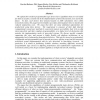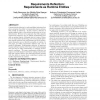511 search results - page 57 / 103 » Arguing and Explaining Classifications |
ASAP
2004
IEEE
14 years 17 days ago
2004
IEEE
We explain how modern programmable logic devices have capabilities that are well suited for them to assume a central role in the implementation of networked systems, now and in th...
AISB
2008
Springer
13 years 10 months ago
2008
Springer
Abstract. The aim of this paper is to try to understand the structure of time in information technologies. Starting with historical arguments, it first shows that time is neither l...
AISC
2008
Springer
13 years 10 months ago
2008
Springer
A child, or young human-like robot of the future, needs to develop an information-processing architecture, forms of representation, and mechanisms to support perceiving, manipulati...
ICSE
2010
IEEE-ACM
13 years 10 months ago
2010
IEEE-ACM
Computational reflection is a well-established technique that gives a program the ability to dynamically observe and possibly modify its behaviour. To date, however, reflection is...
COLT
2008
Springer
13 years 10 months ago
2008
Springer
We consider the question of why modern machine learning methods like support vector machines outperform earlier nonparametric techniques like kNN. Our approach investigates the lo...


